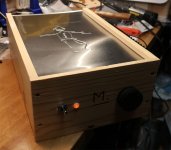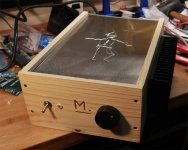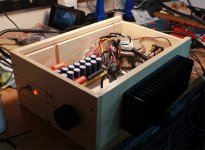Ah, that I do not have. Any recommendations on how to approach that? I guess literal holes bored through the side would be one approach, or perhaps routing a channel on the inside that exits at the back?
If possible orient the heat sinks such that the fins are vertical. Then either let the heat sinks poke through the side of the chassis or drill a bunch of holes below the heat sink fins and above them for the air to flow through.
Tom
Ideally I think you’d want to create a open air path for convection - usually with the fins of heat sinks oriented vertically. With high efficiency class D type amps such as Hypex modules, the thick extruded side panels of something like the DIY Audio store Slimlines work great, but amps like Toms, or the class A ACAs need either surface area exposed to free air, or some other creative heatsink /cooling mechanism with which to dissipate that thermal energy.
OK, I see Tom answered pretty much the same thing
OK, I see Tom answered pretty much the same thing
Guys,
I have really strange issue. I am running stereo lm3886DR with one smps -/+24V (2x60W/24V). On each lm3886dr board instead of two 1000uf caps I put two 3300uf/50V.
When I connect the amp to the 4R speaker I works perfect. Dc offest less thatn 2mV in both channels. I measured the voltage across the caps and it is either -24V or +24V. Everything is just fine. However after some time (5mins) one of the 3300uf cap in one channel get extremly hot! (the other channel does not have this issue). I checked polarity and it is ok. I replace the cap (thining it is maybe faulty one) but a ran into same issue. Then I just removed this cap and everything works fine ...
Any ideas what might have happend? Please help. It is really strange for me. Why this particular cap get so hot?
I have really strange issue. I am running stereo lm3886DR with one smps -/+24V (2x60W/24V). On each lm3886dr board instead of two 1000uf caps I put two 3300uf/50V.
When I connect the amp to the 4R speaker I works perfect. Dc offest less thatn 2mV in both channels. I measured the voltage across the caps and it is either -24V or +24V. Everything is just fine. However after some time (5mins) one of the 3300uf cap in one channel get extremly hot! (the other channel does not have this issue). I checked polarity and it is ok. I replace the cap (thining it is maybe faulty one) but a ran into same issue. Then I just removed this cap and everything works fine ...
Any ideas what might have happend? Please help. It is really strange for me. Why this particular cap get so hot?
One of your SMPSes may be oscillating due to the capacitive load. That would burn significant power in the cap, thereby heating it up.
Tom
Thanks Tom,
But is the increased capacitance the cause of oscilation? or one of the smps oscilates because of different reason (like low ESR of caps) and increased capacitance does not have anything to do with this?
Last edited:
That would work. You could also use microphone cable. Use one conductor for the centre conductor, the other for the shield. Terminate the cable shield at one end (the transmitting end). That would be your standard "audiophile" interconnect cable setup. Just add directional arrows...
You'll probably get better performance if you use one conductor for the shield connection and connect the shield at both ends as that reduces the ground impedance. Of course then the cable won't be audiophile approved as it won't have the directional arrow.
The W2319 you link to above would make sense for the wiring inside the chassis. Use the centre conductor to carry the signal and the shield to carry the ground.
Tom
Would W2524 also work well for RCA to RK271 10K pot to LM3886DR amp?
MOGAMI® - Bulk Guitar Cables
Thank you,
David.
Well, I read the entire thread...
Couple of main points taken and questions,
- Isolate the RCA shells from the main chassis.
- Make sure to use a short ground from mains to chassis, and make sure there is continuity between all chassis parts.
- Keep signal in wires away from Power wires.
- - Is this with regards to mains power in, transformer, power to boards, or amplified signal out wires?
- - Or, what specific wires should I be keeping away from what other specific wires?
- In the corner of the boards, where there are chassis mounting points supports,
- - should nylon screws and posts be used?
- - or is it okay to have those corners go to ground with metal screws and standoffs?
- - should they be non-magnetic like aluminum or brass? Or it doesn't matter?
Thank you,
David.
Couple of main points taken and questions,
- Isolate the RCA shells from the main chassis.
- Make sure to use a short ground from mains to chassis, and make sure there is continuity between all chassis parts.
- Keep signal in wires away from Power wires.
- - Is this with regards to mains power in, transformer, power to boards, or amplified signal out wires?
- - Or, what specific wires should I be keeping away from what other specific wires?
- In the corner of the boards, where there are chassis mounting points supports,
- - should nylon screws and posts be used?
- - or is it okay to have those corners go to ground with metal screws and standoffs?
- - should they be non-magnetic like aluminum or brass? Or it doesn't matter?
Thank you,
David.
Last edited:
I'm not an expert in this field but I'll try to share what I know:
Wires: It's always good to keep signal wires and power wires separated. The signal out (to speakers) are less sensitive than the signal in - but still good to keep them away from the power wires - all power wires. Use shielded wires for signal in. Also keep the signal wires and power wires closely coupled (twisted) - signal with signal power with power that is. I believe this is all mentioned in the Lm 3886 manual.
Assuming you are talking about the lm3886 boards: I don't know. Use your DMM to check if there's continuity between the holes and other parts (ground?) of the boards. if yes - probably better to use nylon posts. if the holes are "isolated" from the rest of the circuit - no need to use nylon screws. I'd use L-brackets to bolt the board to a heat sink. no standoffs needed. I think most standoffs are made of brass anyways - i don't think magnetic / non magnetic matters.
power supply: make sure to check the manual. sometimes one of the pcb holes has to be mounted with a metal post to connect it to GND.
Wires: It's always good to keep signal wires and power wires separated. The signal out (to speakers) are less sensitive than the signal in - but still good to keep them away from the power wires - all power wires. Use shielded wires for signal in. Also keep the signal wires and power wires closely coupled (twisted) - signal with signal power with power that is. I believe this is all mentioned in the Lm 3886 manual.
Assuming you are talking about the lm3886 boards: I don't know. Use your DMM to check if there's continuity between the holes and other parts (ground?) of the boards. if yes - probably better to use nylon posts. if the holes are "isolated" from the rest of the circuit - no need to use nylon screws. I'd use L-brackets to bolt the board to a heat sink. no standoffs needed. I think most standoffs are made of brass anyways - i don't think magnetic / non magnetic matters.
power supply: make sure to check the manual. sometimes one of the pcb holes has to be mounted with a metal post to connect it to GND.
- Or, what specific wires should I be keeping away from what other specific wires?
Keep the input wires away from everybody else if possible.
- In the corner of the boards, where there are chassis mounting points supports,
- - should nylon screws and posts be used?
- - or is it okay to have those corners go to ground with metal screws and standoffs?
- - should they be non-magnetic like aluminum or brass? Or it doesn't matter?
The mounting holes are floating, so you can connect them with whatever material you choose. All materials are magnetic, by the way. Not all materials are ferromagnetic, however.
Tom
Alps Alpine RK271 Series Potentiometers
Hello,
What difference does using a 10K, 20K, 50K or 100K Alps RK271 pot make?
Mouser and Digikey are out of stock and will not have any for at least 4 weeks.
Any other legit sources for them?
I am leery of purchasing one on Ebay that may turn out to be counterfeit.
Thank you,
David.
Hello,
What difference does using a 10K, 20K, 50K or 100K Alps RK271 pot make?
Mouser and Digikey are out of stock and will not have any for at least 4 weeks.
Any other legit sources for them?
I am leery of purchasing one on Ebay that may turn out to be counterfeit.
Thank you,
David.
Most TO-220-ish devices mount with 4-40 hardware and a shouldered plastic 4-40 washer that fits in the 0.150 hole in the tab. There is almost always a thin heat sink pad, such as the Keratherm ones Tom sells between the LM3886 and the heat sink.
The classic text on this is the old Motorola, now Freescale applications note AN-1040.
The classic text on this is the old Motorola, now Freescale applications note AN-1040.
- Home
- Amplifiers
- Chip Amps
- Neurochrome LM3886DR Build


